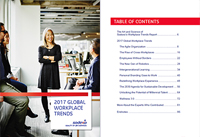Maximizing the benefits of migration
Interview with Jean-Christophe Dumont, Ph.D., Head, International Migration Division of the Directorate for Employment, Labour and Social Affairs, OECD.
 Sodexo 2017 Global Workplace Trends Report is hot off the press with ten major trends that will impact our workplace today and in the years to come. Today we sat down Jean-Christophe Dumont Ph. D., Head of the International Migration Division of the Directorate for Employment, Labour and Social Affairs at the OECD, to talk about the role businesses play in integrating and valuing migrant workers.
Sodexo 2017 Global Workplace Trends Report is hot off the press with ten major trends that will impact our workplace today and in the years to come. Today we sat down Jean-Christophe Dumont Ph. D., Head of the International Migration Division of the Directorate for Employment, Labour and Social Affairs at the OECD, to talk about the role businesses play in integrating and valuing migrant workers.
What’s your stance on migration?
Jean-Christophe Dumont: Migration is part of our lives and it’s here to stay. Some arrived after a corporate promotion, others escaped conflict, some relocated temporarily, others will stay permanently, and many have great-great grandparents who made the journey. Migration, whatever form it takes, if well managed, can be beneficial for all of us. At the moment, we are witnessing the highest level of forced displacement, clearly the highest level of humanitarian need since World War II. We must share in the responsibility of supporting successful integration.
Can you offer some pointers on successful integration?
J.C.D.: There’s no escaping that public policies are central to discussions about migration but the business community has a key role to play in helping to facilitate the integration of migrants. It is in the workplace that people use and develop their skills and make a living to support themselves and their family. Labour market integration is central to migrants’ successful integration in society as a whole. It is crucial that recently arrived migrants invest in new language skills but also that they are supported in this – and the workplace is ideal. It is also important to assess migrants’ professional and informal skills to identify the right employment or retraining opportunities.
What are some other examples of ways that the business community can facilitate the process?
J.C.D.: Successful integration of migrants and their children, and more efficient labour migration management systems responding to real needs, are necessary to strengthen social cohesion as much as they are to maintain and enhance economic competitiveness. This objective cannot be achieved without engaging more with employers, who are making on a daily basis the recruitment decisions.
Engaging with employers can help identify skills gaps to design more effective public policies aiming at better using migrants’ skills. However, this dialogue with employers should go beyond making the business case for migration and should build notably on the corporate social responsibility of employers to convince the public opinion that labour migration is also in the best interest of the local population.
In the context of the unfolding refugee crisis, the OECD, together with UNHCR, has sought to understand better the barriers that businesses face to hiring refugees and asylum seekers. As a result, we have identified issues relating to labour market access, access to information from both employers and refugees, but also to international transferability of skill and qualification transferability.
Competition for skills is intense and there are some shortages in host countries; how helpful is migration?
J.C.D.: There are more than 35 million migrants with tertiary education in the OECD, which represents an unprecedented increase of 70% over the past ten years. More than 25 million of them are of working age. However, although migrants bring skills, unfortunately our labour markets do not yet utilize them to their full potential. One out of three migrants with tertiary education in Europe and in the United States is over-qualified for his or her job. One in two is inactive, unemployed or overqualified. To make the case for easier access to skills from abroad, it is important to better understand why credentials and professional experience acquired abroad are strongly discounted in the host-country labour markets.
This includes recognising that in some cases it is necessary to build on existing skills rather than to ignore them because they don’t quite fit. For example, a car mechanic originating from a less developed country may be excellent in his job, but may lack some of the skills needed to repair a car with lot of electronic devices. Even in the most highly regulated professions, such as medicine and law, the transferability of knowledge and experience can be lengthy and costly, but worth investing in. Employers can help to enhance the overall offer for bridging professional training courses.
How would you summarize the case for business engagement on migration?
J.C.D.: My view is that an inclusive, skilled and engaged labor market with high levels of participation is more likely to be resilient, adaptable and competitive – and all of these things benefit businesses. Those that make demonstrable efforts to promote a sense of belonging among their workforces will be better equipped to fill talent shortages. Whatever their activity, businesses can to help manage the hopes and aspirations of some, the fears and concerns of others.


